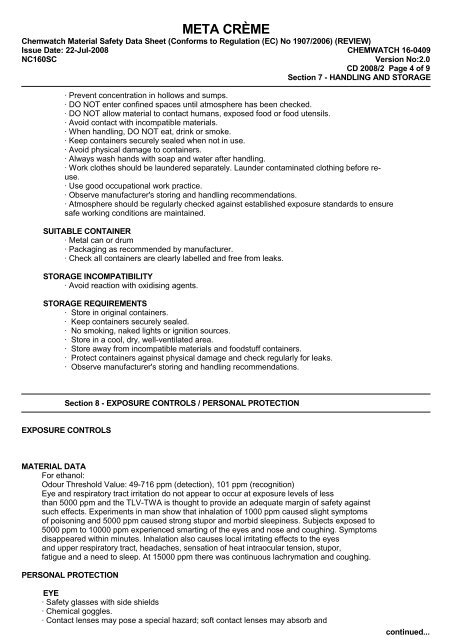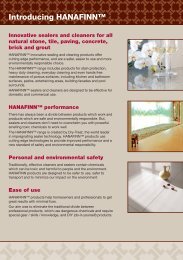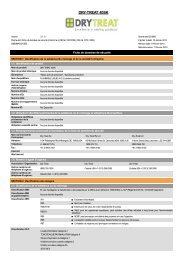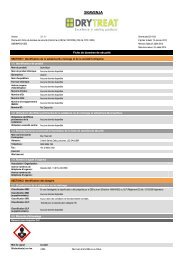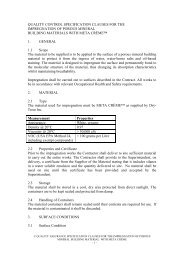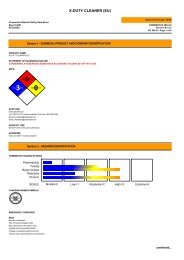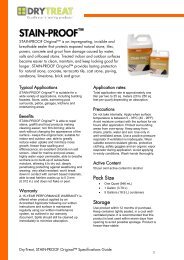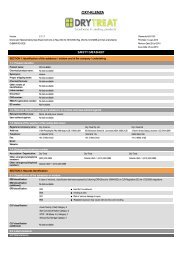meta crème - Pure Adhesion
meta crème - Pure Adhesion
meta crème - Pure Adhesion
You also want an ePaper? Increase the reach of your titles
YUMPU automatically turns print PDFs into web optimized ePapers that Google loves.
META CRÈME<br />
Chemwatch Material Safety Data Sheet (Conforms to Regulation (EC) No 1907/2006) (REVIEW)<br />
Issue Date: 22-Jul-2008 CHEMWATCH 16-0409<br />
NC160SC Version No:2.0<br />
CD 2008/2 Page 4 of 9<br />
Section 7 - HANDLING AND STORAGE<br />
· Prevent concentration in hollows and sumps.<br />
· DO NOT enter confined spaces until atmosphere has been checked.<br />
· DO NOT allow material to contact humans, exposed food or food utensils.<br />
· Avoid contact with incompatible materials.<br />
· When handling, DO NOT eat, drink or smoke.<br />
· Keep containers securely sealed when not in use.<br />
· Avoid physical damage to containers.<br />
· Always wash hands with soap and water after handling.<br />
· Work clothes should be laundered separately. Launder contaminated clothing before reuse.<br />
· Use good occupational work practice.<br />
· Observe manufacturer's storing and handling recommendations.<br />
· Atmosphere should be regularly checked against established exposure standards to ensure<br />
safe working conditions are maintained.<br />
SUITABLE CONTAINER<br />
· Metal can or drum<br />
· Packaging as recommended by manufacturer.<br />
· Check all containers are clearly labelled and free from leaks.<br />
STORAGE INCOMPATIBILITY<br />
· Avoid reaction with oxidising agents.<br />
STORAGE REQUIREMENTS<br />
· Store in original containers.<br />
· Keep containers securely sealed.<br />
· No smoking, naked lights or ignition sources.<br />
· Store in a cool, dry, well-ventilated area.<br />
· Store away from incompatible materials and foodstuff containers.<br />
· Protect containers against physical damage and check regularly for leaks.<br />
· Observe manufacturer's storing and handling recommendations.<br />
Section 8 - EXPOSURE CONTROLS / PERSONAL PROTECTION<br />
EXPOSURE CONTROLS<br />
MATERIAL DATA<br />
For ethanol:<br />
Odour Threshold Value: 49-716 ppm (detection), 101 ppm (recognition)<br />
Eye and respiratory tract irritation do not appear to occur at exposure levels of less<br />
than 5000 ppm and the TLV-TWA is thought to provide an adequate margin of safety against<br />
such effects. Experiments in man show that inhalation of 1000 ppm caused slight symptoms<br />
of poisoning and 5000 ppm caused strong stupor and morbid sleepiness. Subjects exposed to<br />
5000 ppm to 10000 ppm experienced smarting of the eyes and nose and coughing. Symptoms<br />
disappeared within minutes. Inhalation also causes local irritating effects to the eyes<br />
and upper respiratory tract, headaches, sensation of heat intraocular tension, stupor,<br />
fatigue and a need to sleep. At 15000 ppm there was continuous lachrymation and coughing.<br />
PERSONAL PROTECTION<br />
EYE<br />
· Safety glasses with side shields<br />
· Chemical goggles.<br />
· Contact lenses may pose a special hazard; soft contact lenses may absorb and<br />
continued...


